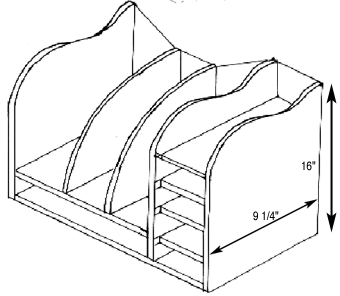 |
|
|
Desk Organizer

Computers seem to create more paper than they save these days, as anyone with a small computer desk can attest to. The battle against clutter is easily lost, making it very difficult to find anything that you need quickly. With this goal in mind (especially in my wife's mind) I finally built a desk organizer and designed it to have small drawers for hiding the more junky items, such as floppy disks, staples and so on. The organizer also had to accommodate the modem and a SyQuest drive, hence the open shelves above and below the drawers.
Construction
Tools Required: Jigsaw, sander, router
Wood List (Pine):
| Description | Qty | Depth | Width | Length |
| Sides | 3 | 1/2" | 9 1/4" | 16" |
| Partitions | 2 | 1/2" | 9" | 9 3/4" |
| Cross member | 1 | 1/2" | 9" | 13" |
| Base | 1 | 1/2" | 9 1/4" | 19" |
| Drawer bases: | 3 | 1/2" | 6" | 8 1/4" |
| Back 1 (hardboard): | 1 | 1/8" | 15 1/2" | 12 3/4" |
| Back 2 (hardboard): | 1 | 1/8" | 15 1/2" | 6" |
| Drawers: (quantities for one drawer) | ||||
| Sides: | 2 | 1/2" | 2 1/2" | 8 1/4" |
| Back: | 1 | 1/2" | 2 1/2" | 4 1/2" |
| Front: | 1 | 1/2" | 3 1/2" | 5 3/4" |
| Base (hardboard): | 1 | 1/8" | 5" | 8" |

Cut the three side pieces to shape, matching the top curve on each one. Note that the "middle" side piece should be 1/2" shorter than the other two as it sits on top of the base piece, whereas the end two side pieces reach all the way to the bottom (butted up against the side of the base piece). Take one side piece and the "middle" side piece and cut the slots for the drawer bases. These slots should be 1/2" wide (and 1/8" deep), starting from 2 1/2", 5 3/4", 8 7/8" and 11 7/8" from the bottom of the middle side piece (and therefore, 3", 6 1/4", 9 3/8" and 12 3/8" from the bottom of the end side piece) -- see diagram. Then, cut a slot 1/8" from the back of each shelf (1/8" wide and deep) that will take the hardboard back (number 2). Note: for the middle side, this slot must be cut into both sides as it connects into both back one and two.
Once these slots have bee cut, glue the drawer bases into the 1/2" wide slots, ensuring that they are perpendicular to the sides, and also glue in back two.
Next, take the cross member piece and cut two slots, evenly spaced, from front to back. These should be 1/2" wide and 1/8" deep and are used to fasten the two partitions into place. Then cut the two partitions to shape (any shape will do as long as they match each other) and then glue into the 1/2" wide slots.

Then, take the final side piece and cut a slot 1/2" wide, and 1/8" deep that starts 3" from the bottom of the piece. At this time, also cut a slot (again, 1/2" wide and 1/8" deep) that is 2 1/2" from the bottom of the middle side piece. These slots are used to fasten in the cross member piece. Then, cut a 1/8" wide, 1/8" deep slot along the back of the side piece, that will allow the back to fasten in.
Once all slots have been made, fasten the side and the drawer unit to the base (using glue and small nails). At the same time, slot in the cross member piece (including the two partitions that should be attached to it). Then, cut the back piece to a suitable shape, so that it dips down to meet the two partitions (see photo and diagram). There is no exact science to this, just cut the back into whatever shape looks good. Once cut, glue the back into the slots in the side pieces, and attach to the partitions by the use of small nails from behind.
Finally, fill in the small gaps in front of the drawer bases by gluing small pieces of wood into these slots. The main unit is now complete and can now be sanded down to a smooth finish.
Drawer Construction
The drawers are very primitive, using no joints. Instead, simply glue and nail the sides to the front and back, and then fill the holes. The one exception to this is the drawer base which should be slotted in, using a 1/8" wide, 1/8" deep slot, as used elsewhere in this project.
When attaching the front of the drawer, the easiest way is to slide the incomplete drawer unit into its designated space, and then nail the front on, thus ensuring that the front is a neat match against the sides, top and bottom of the space. Note that the drawer front should overhang the drawer bases above and below it, so that there is very little space between each drawer front.